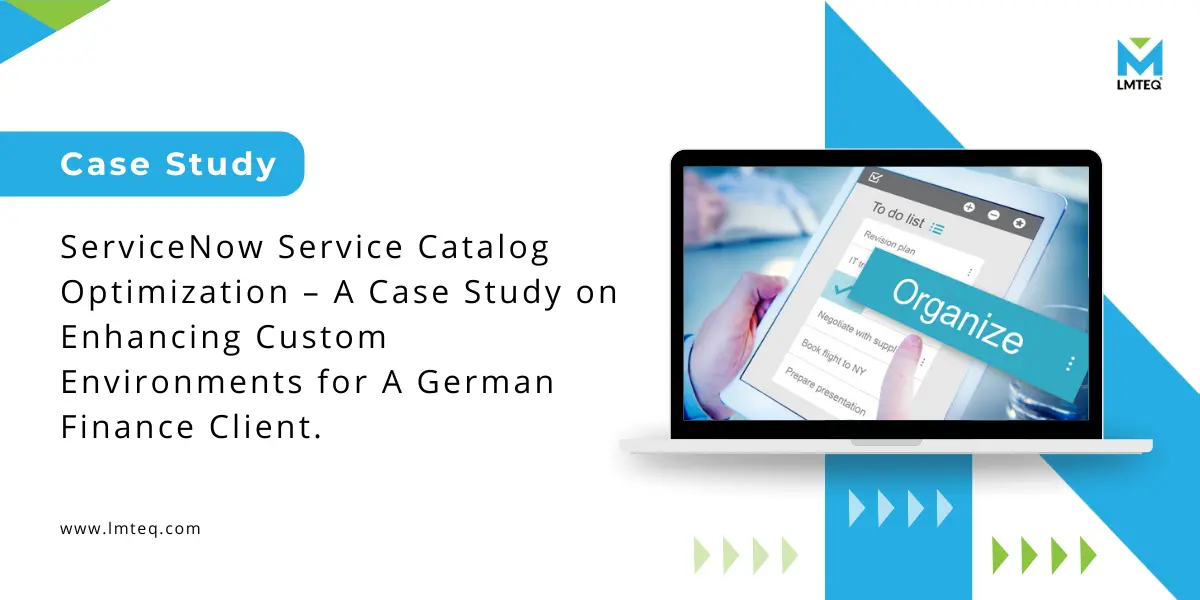Introduction
From creating product descriptions to managing up-to-date assets, catalog management acts as the organization’s cornerstone to deliver tailored IT services or products.
Our client, a German financial services company, specializing in insurance and asset management faced a significant challenge in streamlining service requests and automating workflows across various departments.
In this project, LMTEQ’s ServiceNow consultants were tasked with the challenging endeavor: to not only maintain but also introduce new features to an already highly customized ServiceNow catalog.
The complexity arose from the over-customization of the existing environment, which deviated significantly from standard ServiceNow architecture. This warranted a deep understanding of the custom system architecture, workflows, and integrations that had been developed over time.
The Objective
1. Maintenance
Ensure the existing catalog remains fully operational, with all current functionalities intact, by performing regular updates, addressing defects, and optimizing performance.
2. Feature Enhancement
New, scalable features that align with the client’s evolving business needs. This involved adding new catalog items, optimizing existing workflows, and ensuring seamless integration with other ServiceNow modules such as , and various internal endpoints via Flow Designer.
The Challenges Involved in The Project
Complex Custom ServiceNow Architecture
1. Custom Data Model
The existing ServiceNow CMDB was heavily modified to accommodate the client’s requirements. Existing tables in the CMDB were altered, and new tables were added, which resulted in the “non-standard data model.” Also, the dependencies and relationships between CIs were altered which required a deep understanding of custom schema and how services are altered and related to each other.
2. Custom Workflow
The client’s ServiceNow environment has a bespoke workflow built using Workflow Editor and Flow Designer. These workflows were designed to automate complex business processes, with extensive scripting and custom logic associated with them. The workflows often bypassed “standard ServiceNow practices,” relying instead on custom scripts and third-party integrations.
Due to the heavy modifications, even small change makes a “snowball effect,” across multiple workflows, requiring a thorough understanding of how each workflow interacted with the catalog items.
3. Custom UI/UX
The Service Portal and the Service Catalog interfaces had been deeply customized. Custom widgets, UI policies, and client scripts were used to create a user interface that cater to the client’s branding and UX requirements.
This customization also extended to the Catalog Item Designer, where the standard user interface for creating and managing catalog items was replaced with custom-built interfaces, requiring the consultant to navigate and maintain non-standard code.
4. Integration Framework
The client’s ServiceNow environment was integrated with a plethora of internal and external systems through REST, SOAP APIs, and ServiceNow Flow Designers. Since the integration points were customized to handle large complex data transformations and validations between ServiceNow and external systems, the data was up-to-date and clean.
5. Security and Compliance Layer
There were multiple security layers and compliance checks in the client’s ServiceNow environment. A good amount of custom ACLs, encryption policies, and data protection mechanisms were implemented to meet the client’s tight security requirements.
Without changing the existing security protocols, changes to the Service Catalog imposed a notable challenge.
Managing Complex Dependencies Towards Enhancement
Another key technical challenge faced by the team was managing the complex dependencies between interdependent catalog items, dynamic data populations (CMDB), and the intricate web of custom scripts and business rules that governed their behavior.
The existing service catalog often relies on real-time data from various integrated systems such as HRSD, Asset management, and so on. Any enhancements made resulted in the disruption of the existing operations and performance issues.
Overcoming Challenges
Simplified Custom ServiceNow Environment
To address the challenges of the complex custom ServiceNow architecture, the team undertook a comprehensive review of the modified CMDB, custom workflows, and interfaces.
We mapped the non-standard data model and custom relationships to create detailed documentation, which guided the maintenance and enhancement of the system.
By closely analyzing and documenting custom workflows and custom scripts, the team managed to implement changes incrementally and perform targeted testing to prevent disruptions.
Custom UI/UX elements were updated in collaboration with in-house developers to maintain design consistency, while integration points were carefully monitored and tested to ensure compatibility.
Lastly, security and compliance layers were carefully reviewed to ensure that enhancements adhered to existing protocols without compromising system integrity.
Managing Complex Dependencies Towards Enhancement
To manage the intricate dependencies between catalog items and dynamic data populations, the team employed a structured approach to dependency mapping and impact analysis.
Each catalog item’s dependencies were documented, and a robust testing strategy was developed to simulate real-time scenarios and validate the performance and operational impact of enhancements.
Custom scripts and business rules were reviewed and updated as necessary, with a focus on maintaining data integrity and minimizing disruptions to existing operations.
The team also leveraged staging environments to test changes thoroughly before deploying them to production, ensuring that enhancements were smoothly integrated without affecting ongoing services.
The Results
The ServiceNow Service Catalog optimization and enhancement project resulted in a significantly improved and streamlined Service Catalog that maintained the integrity and functionality of the client’s highly customized environment.
The team successfully integrated new features without disrupting existing workflows or data flows, ensuring seamless operation across all catalog items. The careful management of dependencies and custom scripts led to enhanced performance and reliability of the ServiceNow instance while maintaining compliance with stringent security requirements.
The comprehensive documentation and targeted testing strategies implemented during the project provided a solid foundation for ongoing maintenance and future enhancements, ultimately delivering a more robust and scalable Service Catalog management for the client.

